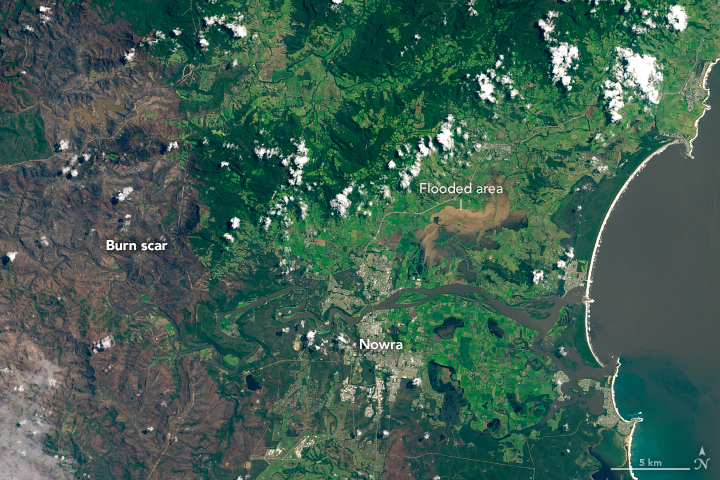Satellite images show transition from fires to floods in NSW
Images captured by a NASA satellite have revealed how the recent rain in eastern Australia has transformed the landscape from fires to floods.
NASA's Landsat-8 satellite continually travels around our planet in a near-polar orbit, capturing detailed images of Earth's surface every day. The resolution of each pixel in these images is 30-metres across, which allows us to see the landscape in extraordinary detail when skies are clear.
Two recent images captured over the Shoalhaven region in NSW show how quickly the landscape changed from fires to floods over the last few weeks.
The first image was taken on January 25th, when smoke could be seen lingering over large burn scars in the bushland to the west of Nowra. At this stage, there were still 54 bush and grass fires burning across NSW, 20 of which were uncontained.

Image: Landsat-8 image from January 25th, 2020 showing smoke and burn scars to the west of Nowra, NSW. Source: NASA
Fast forward a couple of weeks and a slow-moving trough of low pressure dumped close to 300mm of rain on the Shoalhaven region in just three days. This is about two month's worth of rain for Nowra.
A satellite image taken on February 10th shows the result of this deluge, with floodwaters spilling across the landscape and bulging rivers ejecting silty water into the Tasman Sea.

Image: Landsat-8 image from February 10th, 2020 showing floodwaters in the Shoalhaven region and burn scars to the west of Nowra, NSW. Source: NASA
Fortunately, this rain also helped put out a large number of fires in NSW, some of which had been burning for more than six months. The burn scars are still clear to see after the heavy rain.
By February 11th, the number of fires in NSW had dropped to 26, only four of which were yet to be contained.